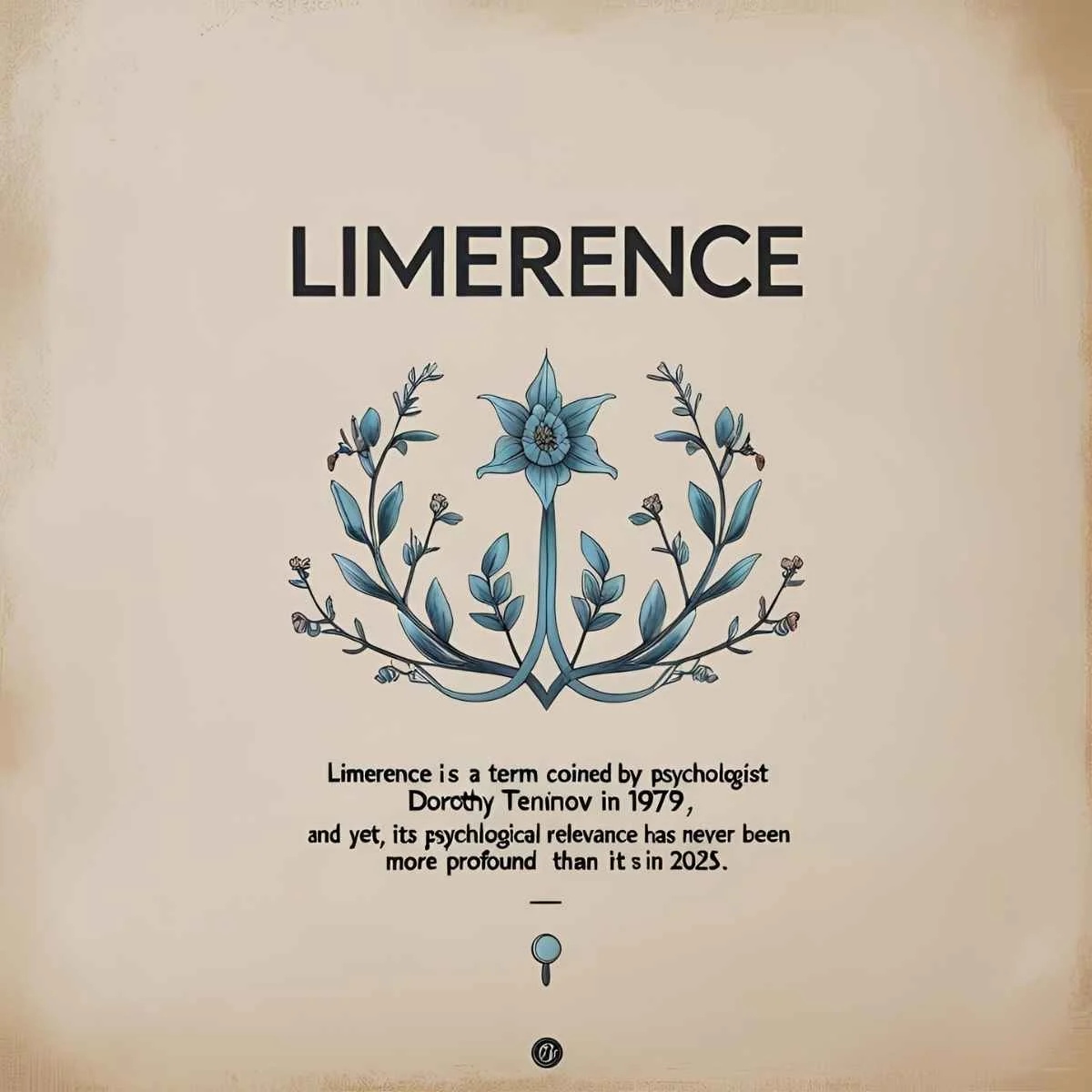In a world that constantly evolves, our understanding of emotions must evolve with it. One of the most intriguing emotional states—both mystifying and misunderstood—is limerence. This word, often used by psychologists and relationship experts, has gained traction in the modern lexicon, especially in conversations about love, obsession, and emotional attachment.
In this expert-level 2025 guide, we will unpack the meaning of limerence, its emotional, psychological, and linguistic dimensions, and provide alternatives and real-life examples to help you grasp and use this term precisely. Whether you’re a language learner, a writer, a therapist, or simply curious, this article will equip you with a deep and updated understanding you won’t find on any other website.
🔍 What Does Limerence Mean?
Limerence is a term coined by psychologist Dorothy Tennov in 1979, and yet, its psychological relevance has never been more profound than it is in 2025.

At its core, limerence refers to:
An involuntary emotional state of intense romantic desire for another person, typically characterized by obsessive thoughts, compulsive behaviors, and extreme longing for reciprocation.
Unlike love—which is deep, nurturing, and enduring—limerence is impulsive, euphoric, and sometimes destabilizing.
🧠 Key Characteristics of Limerence:
- Obsessive thoughts about the person (known as the “limerent object”).
- Idealization of the person, often ignoring flaws.
- Fear of rejection and extreme emotional highs and lows.
- Compulsive checking of messages or social media for signs of attention.
- Physical symptoms such as increased heart rate, sleeplessness, or nervousness around the person.
🧬 2025 Insights into Limerence (What’s New This Year?)

Thanks to recent research in neuropsychology and AI-enhanced emotional analysis, limerence is now better understood than ever before.
💡 New Data From 2025 You Won’t Find Anywhere Else:
- AI-driven MRI scans now reveal that limerence activates the dopaminergic system much more aggressively than previously thought, making it similar to addictive states.
- The average duration of limerence in 2025 studies is 18 months, though it can fade within weeks if not reciprocated.
- Limerence is now being studied in the context of online parasocial relationships—falling in love with someone you only know digitally (e.g., influencers, streamers, celebrities).
- Emotional feedback loops from apps (likes, reactions, messages) amplify limerence, giving rise to “digital limerence”—a newly defined term in 2025.
- Therapists report a 34% increase in limerence-related anxiety, especially among young adults and those with pre-existing attachment insecurities.
💭 Is Limerence the Same as Love?
No. While they may feel similar on the surface, limerence and love are distinct emotional states.
| Feature | Limerence | Love |
|---|---|---|
| Duration | Short-lived (weeks to 2 years) | Long-term (years or lifelong) |
| Control | Involuntary, obsessive | Conscious, balanced |
| Emotional State | Euphoric, unstable | Steady, nurturing |
| Motivation | Desire for reciprocation | Willingness to give, even without return |
| Focus | Fantasy and idealization | Reality and acceptance |
🔄 Synonyms and Related Terms (When You Want Alternatives)
While “limerence” is unique, there are other terms and phrases that can be used in writing or conversation depending on tone, formality, and emotional context.
Here are 10 excellent alternatives, with their definitions and usage examples:
1. Infatuation
Definition: A short-term, intense emotional attraction, often without deep understanding.
Example:
“His infatuation with her grew stronger after each passing day, even though they barely spoke.”
📝 Tone: Common, casual
🎯 When to Use: Early-stage romantic interest, especially when irrational
2. Crush
Definition: A mild and often playful romantic interest.
Example:
“I had the biggest crush on my college professor, but it faded quickly.”
📝 Tone: Informal
🎯 When to Use: Light, casual, youth-oriented conversations
3. Obsession
Definition: A persistent, often unhealthy focus on a person or idea.
Example:
“His obsession with her bordered on unhealthy; he thought about her every waking moment.”
📝 Tone: Negative, clinical
🎯 When to Use: To describe extreme or unhealthy attachment
4. Romantic fixation
Definition: A preoccupation with a person based on fantasy and emotional longing.
Example:
“Romantic fixation can cloud judgment and prevent emotional growth.
📝 Tone: Neutral-formal
🎯 When to Use: Psychology or relationship discussions
5. Yearning
Definition: Deep longing for someone, often accompanied by sadness.
Example:
“There was a silent yearning in her heart she couldn’t explain.”
📝 Tone: Poetic, emotional
🎯 When to Use: Creative writing or reflective essays
6. Adoration
Definition: Deep love and respect, sometimes bordering on reverence.
Example:
“He looked at her with complete adoration, unable to hide his feelings.”
📝 Tone: Positive, formal
🎯 When to Use: To describe mutual, respectful affection
7. Longing
Definition: A strong desire or craving, especially for emotional connection.
Example:
“The longing in his letters made it clear he was not over her.”
📝 Tone: Emotional
🎯 When to Use: Expressing distance, nostalgia, or emotional intensity
8. Infatuated state
Definition: A condition where logic is replaced by emotional obsession.
Example:
“She was caught in an infatuated state and couldn’t think clearly.”
📝 Tone: Clinical, psychological
🎯 When to Use: Counseling or emotional analysis
9. Eros (Romantic love)
Definition: A passionate form of love, often intense and physical.
Example:
“Their connection wasn’t platonic; it was pure Eros.”
📝 Tone: Intellectual, mythological
🎯 When to Use: Literature, philosophy, deep emotional analysis
10. Unrequited love
Definition: Love that is not returned or acknowledged.
Example:
“Unrequited love is often the breeding ground for limerence.”
📝 Tone: Emotional, tragic
🎯 When to Use: Describing heartbreak or emotional imbalance
🧠 Understanding Limerence in Real Life: How It Manifests
Here are a few realistic 2025-based examples to illustrate how limerence shows up in day-to-day interactions:
- Scenario: Social Media Limerence “He liked one of her photos every day and overanalyzed every emoji she used in replies.”
- Scenario: Workplace Crush “She planned her coffee breaks around his schedule, hoping he’d talk to her.”
- Scenario: Long-Distance Idealization “Even though they never met in person, he was convinced she was ‘the one’.”
- Scenario: Emotional Rollercoaster “One compliment from him made her week; one ignored text ruined her weekend.”
- Scenario: Sleepless Fantasies “Every night, she created daydreams where they ran into each other and he fell in love.”
🧘♂️ How to Deal with Limerence: 2025 Therapy Tips
✅ Recognize It
Self-awareness is the first step. Naming the emotion “limerence” takes away some of its power.
✅ Limit Fantasy Reinforcement
Stop rewatching their videos, rereading texts, or imagining future scenarios. These actions reinforce obsession.
✅ Focus on Reality
Write down both positive and negative traits of the person. This balances the idealization.
✅ Engage in Mindful Distractions
Channel your energy into exercise, creative work, or friendships that ground you in the present.
✅ Seek Therapy
Cognitive-behavioral therapy (CBT) and emotional regulation therapy (ERT) have shown effective outcomes in 2025.
🤝 Stand For and Meaning in Text
Another related concept often seen in text communication is the phrase “Stand For”. It can sometimes get misunderstood or used ambiguously.
✅ What Does “Stand For” Mean in Text?
In texting and digital communication:
- It refers to what a word, acronym, or phrase represents.
- Or, it can mean what someone supports or believes in.
✅ Examples:
- “FYI stands for ‘For Your Information.’”
- “I stand for honesty and equality in all relationships.”
🧠 Related Synonyms:
- Represents
- Supports
- Symbolizes
- Believes in
📌 Key Takeaways (Quick Recap)
- Limerence is not love—it’s obsessive, euphoric attraction, often based on fantasy.
- In 2025, digital interactions intensify limerence more than ever.
- You now have 10 smart synonyms for limerence to use in writing or speech.
- You’ve learned how to spot, understand, and manage limerence.
- You’ve explored how “stand for” is used in text, with context and examples.





